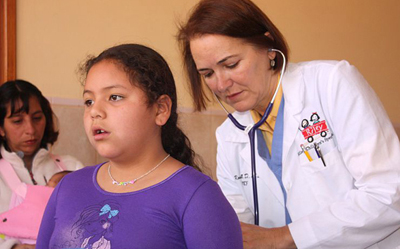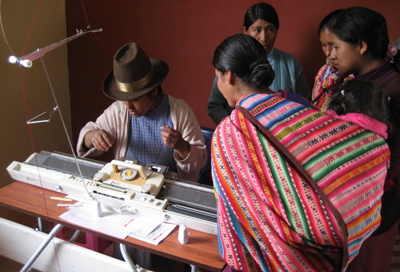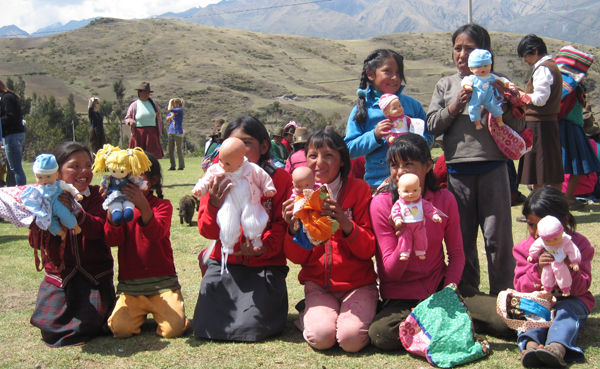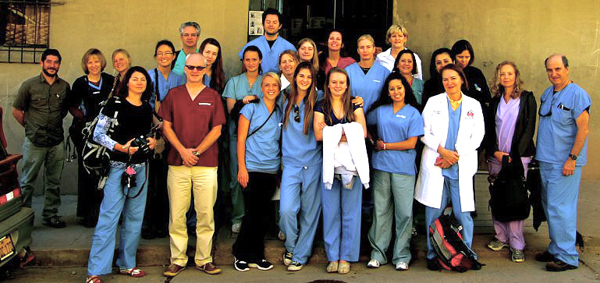UCSF's 'Saint Rose' Inspires People in Rural Peru
They call her Santa Rosa, which means “Saint Rose” in Spanish.
The people of Cusco, Peru, see Rosa Ten, MD, as a compassionate healer with a heart as big as Mother Teresa’s. The UCSF allergy and immunology specialist returned this month from her annual 4,200-mile pilgrimage to Peru to bring much needed healing to the southern part of the country.
Ten is among hundreds of UCSF's health care professionals, educators and researchers working around the world through their own initiatives and Global Health Sciences projects to build sustainable solutions to improve health. Ten has gone on dozens of medical missions during her professional career, including multiple trips to Honduras. In 2005, her philanthropic path veered from Central America to South America when she and her family vacationed in Peru. It was there she met Percy Espejo, a family friend who acted as their tour guide in Cusco.

UCSF's Rosa Ten, MD, examines a young patient at Publiclínico Parroquial Belén, a nonprofit medical clinic in Cusco, Peru.
“I fell in love with the country. It is absolutely gorgeous and the people are really nice,” Ten said. “So we said, ‘Why don’t we come back next year with our doctor friends and try to start a little mission and see how it goes?’”
Forging a New Path
The following year, 2006, Ten led a team of 20 volunteers, each carrying two 50-pound suitcases filled with medical supplies, clothes and toys — 2,000 pounds of gifts for the people of Cusco. Approximately 28 percent of Peru’s population of more than 29 million lives in rural communities, the majority of which are poor.
“There are many organizations that take monetary contributions and you don’t know how much of it is going to get to the people because there are so many bureaucratic steps in place,” she said. “Over there we bring basic necessities and give them to the hands of the people. So I can see what we do helps the people directly.”
Ten does not have direct ties to Peru. The 53-year-old physician was born and raised in Madrid, Spain, graduated from Universidad Complutense de Madrid School of Medicine, and then was trained at Mayo Clinic Medical Center in Rochester, Minnesota. Her Spanish from her native Spain is slightly different from that spoken in Peru, plus many in rural Peru only speak a native Incan dialect . Still, Ten manages to communicate effectively with locals in Cusco and has developed an intrinsic desire to help them.

Women in Chitipampa, Peru, examine new sewing equipment at a textile factory rebuilt by Ten and other donors.
In October Ten’s UCSF colleague allergist/immunologist Katherine Gundling, MD, and her two nieces, joined the trip for the first time, along with 21 others.
“I’ve always wanted to do a medical mission and it’s never quite presented itself in a way that was the right time and I really didn’t want to do it with a big organization,” Gundling said, “so this opportunity with Rosa seemed like the right time and the right place.”
Ten and her team work out of Publiclínico Parroquial Belén, a nonprofit medical clinic in Cusco founded by a Catholic priest to provide affordable health care to the region’s low-income population. Nuns run the clinic throughout the year, but with limited medical training and poor access to supplies, they can’t help as many people as they would like.
That’s where Ten and her volunteers come in. Many are doctors and most have some form of medical training. Most speak Spanish. They provide preventive screenings and basic medical care. They also distribute essentials like toothbrushes and prescription eyeglasses.
“When we go to the clinic, we see about 50 patients during the day,” Ten said. “But then we also take a bus and go to small villages in the mountains. That’s where we see every level of poverty.
“We visit an orphanage and give toys to the small children. For most of them, this is the only toy they will ever see, let alone receive.”
Bringing Smiles to Children
Ten remembers one little girl in particular from last year’s trip. She had hopeful, eager eyes when she bashfully accepted a baby doll wearing soft pink pajamas. Although the little girl was the only one among her seven friends to receive a doll, the others lined up, waiting patiently for a brief moment to hold and love the doll.
Ten’s own children have helped bring smiles to the children of Peru. Last year they gathered their collection of Beanie Babies and stuffed animals — about a hundred in all — cleaned them up, and took them to Cusco.
“At the villages, we started giving away the toys and my daughter said, ‘This is the one I got when I was five and it was my best friend.’ Each one had a memory,” Ten said. “At the end, my son and daughter realized that just the two of them had brought so much joy to the children of two entire villages just with the things they had.”

Young girls hold up dolls given as gifts by Ten's volunteers. These are the first dolls these girls have ever owned.
Resources are limited in Cusco. Nuns at Publiclínico Parroquial Belén typically treat patients with indigenous herbs and plants. Western medicine is a novel concept in the region.
“They’re basically marveling at what we do. This is something that’s magical for them,” said Ten’s daughter, Claudia Paya Ten. “They kind of see us as these beings that come here to heal them. They’re hoping we’re going to cure everything in the world.”
Rebuilding a Factory
One of the villages from which patients come to the clinic is Chitipampa, just southeast of Cusco. It is among the poorer communities in the area and the majority of residents do not speak Spanish. Chitipampa once was an industrial town, but its textile factory shut down years ago, leaving behind a metal carcass and dashed hopes for a better future. Locals have long believed that if they could somehow renovate the building, they could bring prosperity back to Chitipampa.
Ten told friends about the factory. Between her own contributions and friends’ donations, Ten raised more than $11,000 to help renovate the building.
“I thought that could transform the lives of so many people there,” she said.
Over the course of a year, construction workers rebuilt the factory and moved in newly purchased textile equipment.
“But then I said, ‘What now? What do we do?’” Ten said.
Building a Long-Term Partnership
What started out as a purely medical mission has evolved into a quest to help the local people of Southern Peru become self sufficient.
A week before her trip to Peru, Ten stopped by a locally owned baby clothing store in San Francisco called Bella Blue to pick up a present for a friend. Ten struck up a conversation with the owner, Michelle Salas, who lamented she wasn’t able to keep up with growing demand for her clothing line. She said she had had to turn down offers from large stores who wanted to carry her merchandise.
Salas, who is half Peruvian, travels to Peru at least once a year looking for women who can knit her clothing. Salas told Ten she needed a factory.
“And I told her I have a factory!” Ten said. “So when she heard my story, she said, ‘This is absolutely perfect. This is exactly what she was looking for.’”
Salas said she plans to rent the factory and employ 60 families —75 percent of the working population of Chitipampa. She wants to build a long-term partnership with the community, eventually helping build schools and infrastructure.
“I think Michelle is an angel who came to help me,” Ten said. “I’m very excited for Peru.”

UCSF's Rosa Ten and her team of volunteers in front of the medical clinic in Cusco, Peru.